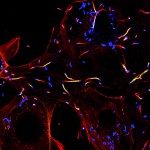Link to Pubmed [PMID] – 22535666
Blood 2012 Jun;119(24):5640-9
Impressive advances in defining the properties of receptors for the Fc portion of immunoglobulins (FcR) have been made over the past several years. Ligand specificities were systematically analyzed for both human and mouse FcRs that revealed novel receptors for specific IgG subclasses. Expression patterns were redefined using novel specific anti-FcR mAbs that revealed major differences between human and mouse systems. The in vivo roles of IgG receptors have been addressed using specific FcR knockout mice or in mice expressing a single FcR, and have demonstrated a predominant contribution of mouse activating IgG receptors FcγRIII and FcγRIV to models of autoimmunity (eg, arthritis) and allergy (eg, anaphylaxis). Novel blocking mAbs specific for these activating IgG receptors have enabled, for the first time, the investigation of their roles in vivo in wild-type mice. In parallel, the in vivo properties of human FcRs have been reported using transgenic mice and models of inflammatory and allergic reactions, in particular those of human activating IgG receptor FcγRIIA (CD32A). Importantly, these studies led to the identification of specific cell populations responsible for the induction of various inflammatory diseases and have revealed, in particular, the unexpected contribution of neutrophils and monocytes to the induction of anaphylactic shock.
